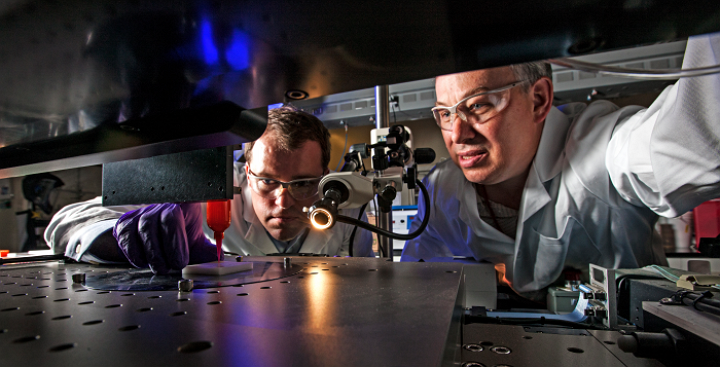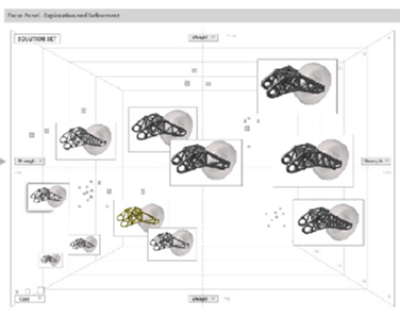 Teams of researchers from Lawrence Livermore National Laboratory (LLNL) and Autodesk have signed an agreement which will see them begin work on exploring ways design software can be used to accelerate innovation for 3D printing of advanced materials.
Teams of researchers from Lawrence Livermore National Laboratory (LLNL) and Autodesk have signed an agreement which will see them begin work on exploring ways design software can be used to accelerate innovation for 3D printing of advanced materials.
The 18-month-long Cooperative Research and Development Agreement (CRADA) means the LLNL team will use software for generative design from Autodesk Inc. to study material microstructures.
 This project will use key technologies such as additive manufacturing, material modeling and architected design which will arrange materials at the micro- and nanoscale levels through computational design.
This project will use key technologies such as additive manufacturing, material modeling and architected design which will arrange materials at the micro- and nanoscale levels through computational design.
The LLNL and Autodesk project will study ideas for next-generation protective helmets as a test case for the collaboration to examine ways to improve design performance, and as helmets represent objects which require lightweight structure and must absorb impact and dissipate energy predictably, they say the project is ideal for studying advanced additive manufacturing techniques.
The LLNL and Autodesk teams will be tasked with creating complex material microstructures capable of dissipating energy more effectively than current manufactured helmet pads made with foams and pads.
“As an organization that is pushing the limits on generative design and high-performance computing, Autodesk is an ideal collaborator as we investigate next-generation manufacturing,” said Anantha Krishnan, the associate director for engineering at LLNL.
Mark Davis, the senior director of design research at Autodesk, says focusing on helmets will provide an excellent example of a design problem with multiple objectives.
“The difference in the design method we are proposing versus historically is that many of the previous manufacturing constraints can be eliminated,” says Eric Duoss, a materials engineer and the co-principal investigator for the LLNL team with computational engineer Dan White. “Additive manufacturing provides the opportunity for unprecedented breakthroughs in new structures and new material properties for a wide range of applications.”
While the kinds of helmets to be created have yet to be determined, Duoss thinks football, baseball, biking and skiing versions are likely candidates.
“One of the important things we hope to gain from this CRADA is to know what a great helmet design looks like, and we aim to build and test components of those helmet designs,” he said.
Over the course of the last couple of years, the LLNL Additive Manufacturing Initiative team has used 3D printing to produce novel ultralight and ultrastiff mechanical materials, mechanical energy absorbing materials and printed graphene aerogels.
The LLNL team will also include computational engineers Nathan Barton, Mark Messner and Todd Weisgraber; chemical engineer Tom Wilson; materials engineer Tim Ford; chemist Jeremy Lenhardt; applied physicist Willy Moss; and mechanical engineer Michael King.
What do you think about this deal between Lawrence Livermore National Laboratory and Autodesk Research to study materials and AM techniques for manufacturing helmets? Let us know in the LLNL and Autodesk Research forum thread on 3DPB.com.
Subscribe to Our Email Newsletter
Stay up-to-date on all the latest news from the 3D printing industry and receive information and offers from third party vendors.
You May Also Like
High Stakes, High Speed: KVG Acquires 15 Nexa3D HSE 3D Printers to Boost Military Tech
As 3D printing increasingly intersects with defense and military logistics, a new partnership between Nexa3D and mission support logistics firm KVG stresses the growing importance of this technology in strategic...
3D Printer Maker EVO-tech Reborn as NEVO3D — Once More With Feeling
EVO-tech was a 3D printing service and original equipment manufacturer established in 2013 and based in Schörfling am Attersee, Austria. The company produced high-quality material extrusion systems featuring linear bearings,...
3D Printing News Briefs, March 16, 2024: Partnerships, Affordable Bioprinter, & More
We’re starting with dental 3D printing news today, and then moving on to some new partnerships. Then it’s on to some interesting university research about 3D printing plant-based pharmaceuticals, but...
FDR vs. SLA: The Right Polymer Manufacturing Choice for Your Application
The additive manufacturing (AM) industry has no shortage of acronyms when it comes to the various methodologies of industrial 3D printing. In polymer 3D printing, there are three main methods...































